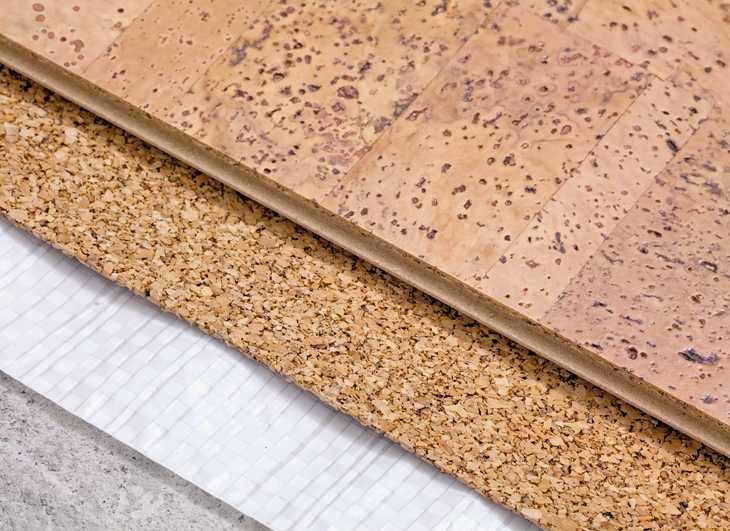How much is cork??

Cork flooring has many advantages and is therefore often used in apartments and houses. Not only that it is particularly suitable for allergy sufferers and stores heat, it is now available in all imaginable shapes and patterns, up to the stone or tile look.
One of its few disadvantages: basket flooring is not cheap. For an area of 30 square meters, laying cork flooring can cost between 1,000 and 4,000 euros.
Cost composition for laying cork floor
First of all, of course, the cost of the material itself to book.
The material prices are between 15, – and 70, – Euro per square meter and depend on the properties of the material.
Depending on the place of use, you can choose between varnished and oiled cork, for example. Painted cork looks unnatural in some cases, but is easier to care for.
There are cork in the following forms:
- oiled
- lacquered
- natural
- treated with wax
Cork as a covering needs an insulating and insulating substrate. With click cork, the material costs are higher, but you save on the craftsman costs, because the installation is done easier and faster.
On the other hand, if the cork floor is to be classically laid and glued, the effort for the craftsman is greater.
The labor costs for the craftsman are calculated on a per square meter basis and, depending on the region and the company, are often between € 20 and € 60 per square meter.
Ask if a fixed price per square meter already includes the sealing of the cork floor. If not, you can plan for about 30, – to 50, – Euro per working hour.
In addition, often incurred additional costs for the laying of edge strips and the removal of the old flooring.
Depending on the type of old flooring, the removal may cost you another 5, – to 20, – Euro per square meter. The laying of edge strips is calculated per meter. Usually prices are from 6, – to 8, – Euro per running meter.
If under the new cork floor even a mold protection film is laid, it costs you about 1, – to 2, – Euro per square meter.
Cost of cork floor – tabular overview
| cost factor | Price per m² | Cost example 10m² | Cost example 30m² |
|---|---|---|---|
| total | 35, – to 130, – Euro | 350, – to 1,300, – Euro | 1.050, – to 3.900, – Euro |
| material Price | 15, – to 70, – Euro | 150, – to 700, – Euro | 450, – to 2,100, – Euro |
| labour costs | 20, – to 60, – Euro | 200, – to 600, – Euro | 600, – to 1,800, – Euro |
All prices are approximate values including VAT and may of course vary.
Laying the cork floor
Cork can be laid on almost any surface such as screed, concrete or even on tiles. The main thing is that the surface is clean and dry.
The material is laid without glue using a click system. This technique is also called the floating installation and the end product cork parquet.
If you plan to lay your cork floor in a room that tends to be damp, such as a kitchen or bathroom, the floor covering must be glued. With a solvent-free glue then the cork layers are glued and sealed afterwards.
Cost of removal and repair of cork flooring
If you want to remove old cork flooring, you do not even have to hire a craftsman.
If the flooring is floating, so laid without glue, it is sufficient to loosen the skirting boards and you can easily lift the panels.
Even cork is not a major obstacle. A normal hair dryer is usually sufficient to release the glue. Align the hot air on the cork plate until it can be removed with a spatula. Alternatively, of course, it also does a solvent.
With particularly strong glue only a pneumatic hammer helps. You can rent this tool for around 20, – Euro per day.
Cork flooring can be disposed of at a recycling center. The disposal of smaller quantities is often free of charge.
Already knew? Natural cork can also be recycled. Cork collection points in your area can be found here.
Partly an old cork flooring can also be brushed up again. The grinding and re-sealing of a cork floor by a professional will cost you about 30, – to 50, – Euro per working hour.
Of course you can do this work yourself. But beware! Not all cork floors can be sanded off. For sanding, only floors made of solid or layered cork, which have been sealed with a layer of varnish, are suitable.
If the floors were only oiled or impregnated, there is no layer that could rub you off. Here it is better, you simply oil or impregnate your soil again.
Be careful with cork veneer or cork flooring with a vinyl coating. The use of a grinder would cause irreparable damage here.
To remove the old paint layer, you must first thoroughly clean your floor. Then two sanding cycles are performed, first with coarser, then with finer sandpaper. For example, 40s and 120s or 60s and 150s sandpaper are recommended.
Renting a grinder costs you between 30, – and 50, – Euro per day.
Afterwards, and best of all between the individual grinding cycles, you must thoroughly clean the floor again.
Then you can decide if you want to re-paint or oil it. One liter of paint costs between 15, – and 30, – €, a liter of oil between 20, – and 30, – €.
Advantages and disadvantages of cork flooring
Cork is now available in every conceivable color and pattern variant. Also cork floors in tile look are already available.
Cork floors offer a pleasant running and warmth comfort. Cork flooring has become increasingly popular in recent years. As an easy-care alternative to PVC, parquet and laminate flooring, it consists of pure natural raw materials.
Cork is made of bark of cork oak and comes in a variety of forms to use. The production of cork from cork oak is very environmentally friendly and sustainable. In addition, it is 100 percent recyclable.
In homes and houses (also with underfloor heating), it is particularly preferred because of its thermal and acoustic insulation.
Cork floors are antistatic, do not accumulate dust and mites and are very easy to clean. Thus, they are best suited for allergy sufferers.
With clean water or a broom, the surface can be cleaned well.

The insulating property allows it to store oxygen and heat over a long period of time. The heating costs are thus lowered in the long term.
Because of its high elasticity and skid resistance, it is also very gentle and soothing for the joints and spine. Another advantage is that cork burns only hard, but is also insensitive to water.
The flooring also impresses with its longevity and low abrasion. With cork as flooring, the advantages outweigh, but there are a few little things to note.
One of the most significant drawbacks of cork floors is that they are stretchy and can therefore accept prints of furniture. For the same reason, they can only be laid with an expansion joint.
Although cork flooring is a good heat storage, not all cork floors (especially thicker variants) are suitable for underfloor heating. Another disadvantage is that the raw material is quite expensive compared to other floor coverings.
You are still not sure which flooring you want? What a laminate floor costs, learn here.
Has this article been helpful? If so, we look forward to your positive review! This will help us to make acquainted with preisblick.de!
Now click on “5 stars” on the far right. Many thanks!
(28 Rating (s), on average: 4.00 of 5)
Related Posts
-

Contact lenses – cost variants in overview
What do contact lenses cost?? There are some good reasons to wear contact lenses rather than glasses. Apart from the aesthetic aspect, contact lenses…
-

Veneers – cost – variants in overview
What do veneers cost?? A radiantly beautiful smile is considered attractive and is sought by many people. In order to achieve this, veneers are often…
-

Wallpapering – cost – effort in the overview
What does wallpapering cost? Whether it is to visually alter a room or a renovation requires it: from time to time wallpapering walls. It is advisable to…
-

Screed – cost variants at a glance
What does screed cost?? Screed forms the substrate for a wide variety of floor coverings. Depending on the type of screed, the costs are often between…

